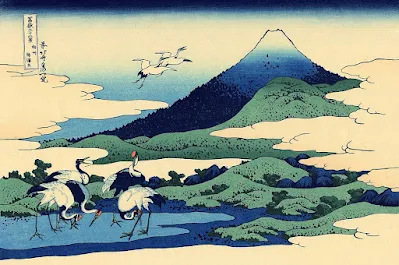 |
| The Great Wave off Kanagawa by Katsushika Hokusai (1831) |
The Great Wave off Kanagawa created by Japanese artist, Katsushika Hokusai, is Japan's most famous artwork.
Beyond its commercialized reputation lies a rich cultural, artistic, and spiritual significance.
Let's get to know more about this iconic wave.
This is an introduction to The Great Wave off Kanagawa.
Context: Japan's Edo period, woodblock prints, and Ukiyo-e art
The Great Wave off Kanagawa was crafted in 1831, during Japan's Edo period.
It is the first in Hokusai's Thirty-six views of Mt. Fuji series, depicting Mt. Fuji from various angles.
 |
| Another print from Hokusai's Mt. Fuji series: Umezawa in Sagami province (1830) |
The series comprises woodblock prints, a technique of carving images into woodblocks and transferring them to papers for mass production.
 |
| Example of Japanese woodblock print of The Great Wave off Kanagawa. |
These prints embody Ukiyo-e, which translates in English as "Images of the floating world."
Ukiyo-e art depicts female beauties, folk tales, theater, and erotica, aside from landscape scenes.
_Three_Beauties_of_the_Present_Time,_MFAB_21.6382.jpg) |
| Ukiyo-e art: Three beauties of the present day by Utamaro (1793) |
Hokusai's Mt. Fuji series, specifically the great wave, gained him the most acclaim as an Ukiyo-e artist.
Technique: Art of East and West
During the Edo period, Japan followed a trade restriction policy known as
Sakoku, allowing trade only with China and The Netherlands.
Artworks from The Netherlands were influential to Hokusai's great wave. His depiction of a sea scene is a clear homage to Dutch seascape paintings.
 |
| Ships in distress off a rocky coast by Dutch painter, Ludolf Bakhuizen (1667) |
He also used an imported pigment for the Mt. Fuji series called
Prussian blue which came from Germany.
The influence of Eastern art lies in Hokusai's treatment of Mt. Fuji. It is the artwork's subject but placed in the background, an occupation characteristic of Japanese art.
 |
| Distant Mt. Fuji framed by the great wave and a fishing boat. |
The wave's dynamism and the fishermen's labors create an image of perturbation unique to Eastern art.
 |
| The Great Wave's dynamism is most pronounced in the impression of claws at its crest. |
There are three main elements in the great wave: (1) Mt. Fuji, (2) the three Ushiokure-bune (fishing boats), and (3) the cascading wave.
 |
| Showing the three elements in the Great Wave. |
The cartouche on the upper left side contains the work's title and Hokusai's signature.
 |
It reads: "Thirty-six views of Mount Fuji / On the high seas in Kanagawa / Under the wave / from the brush of Hokusai, who changed his name to Litsu" |
Symbolisms: Immortality, Treaty, and Calamity
Spiritual symbolism
The Great Wave's spiritual meaning comes from a mix of Shinto and Buddhist beliefs, specifically about Mt. Fuji.
 |
Scene from the tale of the bamboo cutter:
Princess Kaguya returns to the moon by Yoshitoshi (1888) |
In this story, a Japanese emperor ordered the Elixir of Immortality to be burned at Mt. Fuji's summit for its smoke to reach the heavens.
Hokusai emphasized this idea of immortality by contrasting a destructive wave to a still Mt. Fuji.
Cultural symbolism
Japan's Sakoku policy ended in 1853 when the Americans, led by the naval forces of
Commodore Matthew Perry, compelled Japanese trade through a show of arms.
 |
| Commodore Perry's fleet, on his second visit to Japan in 1854 (unknown artist) |
The Japanese, lacking the power to retaliate, soon signed a treaty of commerce.
20 years earlier, Hokusai alluded to the event by interpreting a wave of Western trade about to engulf Japan and the Japanese people, as represented by Mt. Fuji and the fishermen.
Natural symbolism
The Great Wave depicts nature's force in contrast to human struggle.
The fishermen's toil is a message of perseverance. It is a reminder of courage during calamity.
 |
| Ibid. |
Mt. Fuji's distant presence, on the other hand, reminds us to be unmoved in the face of such dares, echoing the enduring spirit of the iconic mountain.
Conclusion: An Enduring Wave
Today, The Great Wave off Kanagawa is the most widely reproduced image in art history.
 |
| 1000 Japanese yen banknote issued in 2024. |
Only 111 copies of its estimated 5,000 to 8,000 original prints remain.
They are kept in prominent museums like The Metropolitan Museum of Art in New York, The Art Institute of Chicago, and The British Museum in London.
References:
Articles
Photos
Youtube videos
Resource for further learning:



_Three_Beauties_of_the_Present_Time,_MFAB_21.6382.jpg)










.png)

Comments
Post a Comment